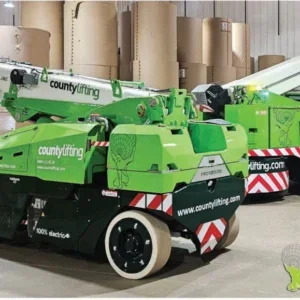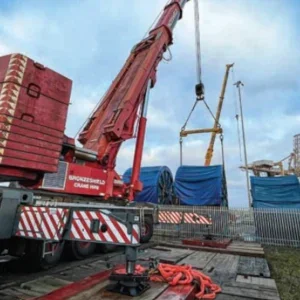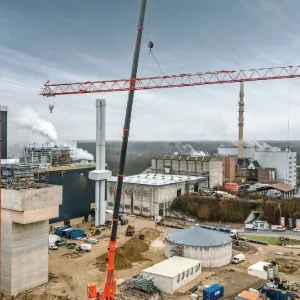There can’t be many industrial locations more idyllic than the hills of Lombardy, home to Fassi’s headquarters. The company has six separate manufacturing sites around the town of Albino, along with two offices and a cranes and components warehouse. Fassi takes pride in the fact that all of its cranes are built entirely in Italy, and believes this helps ensure consistent quality standards. Even the plastic covers used on parts of the crane are moulded by a supplier in Albino.
The tour of the site started off with a visit to the company’s large crane testing site. Here, one of the company’s new F950XP was put through its paces. Launched earlier this year, the crane offers lifting capacities of up to 80.1tm, or 22t at 3.5m on the four extension model. Other models can lift up to 300kg at a reach of 37.35m. The crane is available with four to eight extensions and with a choice of two six-extension fly jibs. Fassi says that the crane is extremely light for its class: the base model has a ‘dry weight’ (excluding oil, bolts, etc) of 7,300kg. The first models of the crane have now been delivered.
Moving on from the the large crane testing area, visitors were taken to the site where Fassi assembles its medium size models. Managing director Giovanni Fassi showed visitors around the 15,000sq m site, purchased two years ago. The company, Fassi said, has taken steps to reduce the environmental impact of its production sites, by, for example, using demineralised water, rather than solvents, to clean components. This cuts pollution, while a thermal heating and cooling system in the company’s offices cuts its energy usage.
In the medium range plant, boom sections are assembled, mounted onto column sections, and jibs are attached. The boom section assembly, Fassi pointed out, is one of the most demanding parts of the job, requiring tight tolerances to ensure the boom sections fit exactly, so the boom doesn’t shake when used. Once it is assembled, it is attached to the column, which is mounted on a rotating and swivelling platform. Finally, the jib is attached to the boom.
The tour moved onto another new plant, where Fassi is in the middle of installing four robotic welding machines. Two have been installed so far, and when all four are in place, it will be possible to simultaneously fabricate the three main components of a knuckleboom crane (column, boom, and jib) in just 15 minutes. The company is also installing a new six-table boring machine.
The final stage of the tour was a visit to the company’s crane and components warehouse. Luigi Porta, export manager, explained how the company is working to improve parts delivery times. In line with the adage, ‘You make the first sale on features, and the second on service’, the company is working to ensure next day parts delivery across Europe.
The company moved crane shipping and parts to a new 5,000sq m warehouse in 2006, around a third of which is dedicated to parts. Over a week in 2007, 21 Fassi staff went through the warehouse, coding up 5,000 different component types. Last year, Fassi shipped 300,000 different components. This year, the number of parts shipped is up 50%, year-on-year.
The company has recently installed a new automated handling system, used to store and retrieve small components. This will soon be integrated with its parts ordering system, meaning distributors and service technicians can order parts through a website, have them automatically picked out by the system, and get an immediate availability and delivery time report. In Europe, the target will be to have every part delivered overnight.
—–
You can view all of the photos from this visit on Cranes Today’s photo and video news page.






